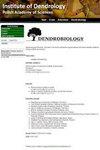柳树体外培养条件下微生物辅助植物提取Cd2+的研究
IF 1.8
4区 农林科学
Q2 FORESTRY
引用次数: 0
摘要
微生物辅助植物修复被认为是重金属污染土壤修复中最有前途的生态友好解决方案。体外实验可以是一个有利的系统,允许评估合作伙伴(例如植物-微生物)的兼容性和效率,从而减少了该技术初始阶段的时间和空间。本研究的主要目的是:(1)利用柳树(Salix viminalis L.)接种三种链霉菌(Streptomyces sp.)菌株,在体外条件下计算Cd2+积累因子(BCF、Ti、AF);(2)将所得结果与Złoch等人(2017)的盆栽实验结果进行比较。研究结果表明,链霉菌接种柳树后,柳树的Cd2+积累能力显著增加,表明植物提取受到了微生物的刺激。此外,接种植株生物量增加,脂质过氧化水平降低。结果表明,Strep-1和Strep-2显著提高了接种植株地上部分的MEA、BCF、Ti、MER含量。此外,3株菌株中,Strep-1 (Streptomyces sp. SIIB-Zn-R8)对Cd2+植物提取效率影响最大。综上所述,该体外模型系统可以预测接种柳树植物提取Cd2+的能力,且时间和空间都显著减少。本文章由计算机程序翻译,如有差异,请以英文原文为准。
Microbial assisted phytoextraction of Cd2+ by Salix viminalis under in vitro culture conditions
Microbially assisted phytoremediation is considered as the most promising eco-friendly solution for recultivation of heavy metal polluted soils. In vitro experiments can be favorable systems that allow assessing compatibility and efficiency of both partners (e.g. plant-microorganism) which reduces time and space in the initial stages of this technology. The main objective of this study was: (1) to calculate the Cd2+ accumulation factors (e.g. BCF, Ti, AF) using willow (Salix viminalis L.) inoculated with three Streptomyces sp. strains under in vitro conditions and (2) to compare obtained results with that derived from pot experiments by Złoch et al. (2017). Our results reveal significantly increase in Cd2+ accumulation capacity of Streptomyces spp. inoculated willow plants, indicating microbial stimulation of phytoextraction. Additionally, inoculated plants showed higher biomass production and lower lipids peroxidation level. The results revealed significant increase of MEA, BCF, Ti, MER by Strep-1 and Strep-2 in the above-ground parts of inoculated plants. Moreover, of the three strains tested, Strep-1 (Streptomyces sp. SIIB-Zn-R8) demonstrated the highest impact on the Cd2+ phytoextraction efficiency. In conclusion, the proposed in vitro model system allowed predicting Cd2+ phytoextraction capacity performed using inoculated willow plants with the significant reduction of both time and space.
求助全文
通过发布文献求助,成功后即可免费获取论文全文。
去求助
来源期刊

Dendrobiology
农林科学-林学
CiteScore
2.20
自引率
11.10%
发文量
17
审稿时长
>12 weeks
期刊介绍:
Dendrobiology publishes original research articles and review articles related to the biology of trees and shrubs.
 求助内容:
求助内容: 应助结果提醒方式:
应助结果提醒方式:


